Key takeaways:
- Selective mutism is an anxiety disorder that restricts verbal communication in certain social situations, causing feelings of isolation and a desire for connection.
- Raising awareness and understanding of selective mutism is vital for fostering empathy, dismantling stigma, and encouraging those affected to seek help.
- Effective support strategies include creating safe environments, encouraging gradual exposure to social situations, and fostering empathy among peers.
- Personal reflection through journaling and exploring alternative forms of expression can aid in self-discovery and build self-empowerment in individuals facing selective mutism.
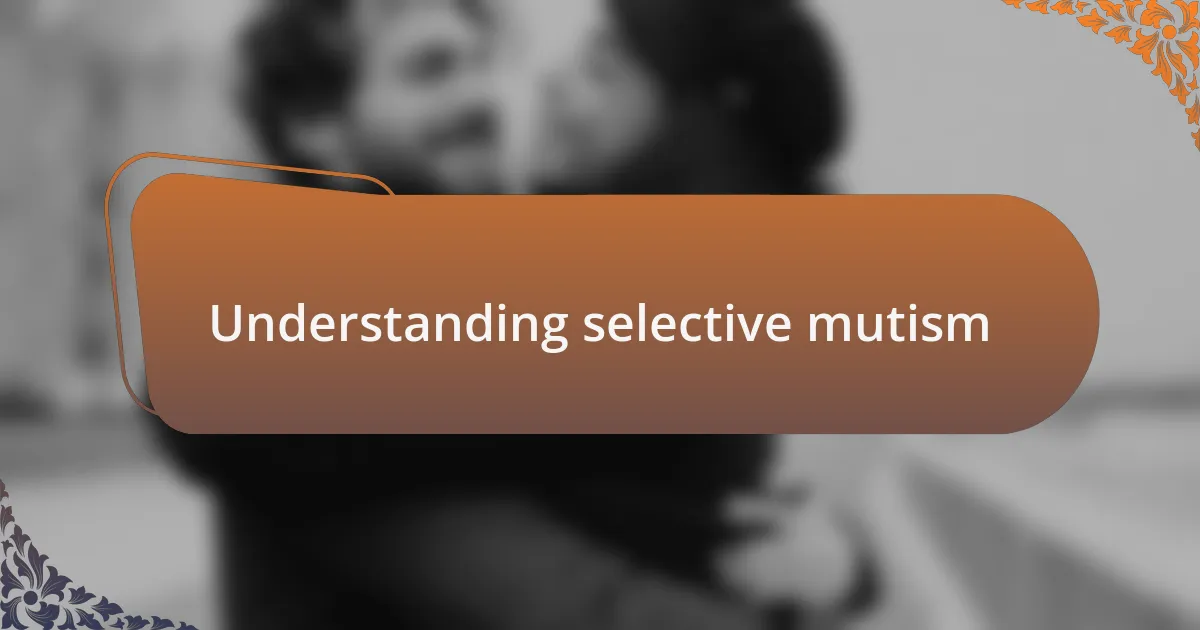
Understanding selective mutism
Selective mutism is a complex anxiety disorder that affects a person’s ability to speak in certain situations, most often in social settings. I vividly remember a time in elementary school when I clung to my friend’s sleeve, terrified to speak in front of the class. It wasn’t just the fear of being judged; it was an overwhelming anxiety that silenced my voice when I needed it the most.
Understanding this condition goes beyond just silence; it dives deep into the emotional turmoil individuals experience. Have you ever felt like your voice was taken from you just when you wanted to express yourself? For many with selective mutism, this feeling is a daily struggle, leading to isolation and a sense of being misunderstood. Each non-verbal interaction can be exhausting, yet it reveals the rich inner world they inhabit, longing for connection but held captive by their fears.
It’s also crucial to recognize that selective mutism isn’t a choice; it’s a reaction to extreme anxiety. I’ve seen friends how they shrugged off their silence, but their eyes spoke volumes about what they couldn’t convey verbally. This condition often confuses those who aren’t familiar with it, leading to misconceptions that the individual is simply being uncooperative or shy. Yet, underneath those quiet exteriors lies a powerful desire to communicate, if only the anxiety could be soothed.

Importance of awareness
Raising awareness about selective mutism is essential in fostering empathy and understanding in the community. I recall a moment when I overheard a teacher mistakenly label a student with selective mutism as “rude” for not participating in class discussions. Sometimes, a little awareness can transform judgment into patience, allowing us to see the struggle behind the silence.
Awareness plays a pivotal role in encouraging those affected to seek help and speak about their experiences. I remember the relief I felt when a counselor recognized my challenges and shared resources tailored for people like me. It’s empowering to know that there are others who understand the internal battle with anxiety, and this recognition alone can be the first step toward healing.
Additionally, increasing awareness helps to dismantle the stigma surrounding this disorder. When we engage in conversations about selective mutism, we create a safe space for individuals to share their thoughts without fear of misunderstanding. Have you ever felt the weight of silence lifted by a simple act of understanding? This creates an opportunity not just for healing but for building connections that transcend words.
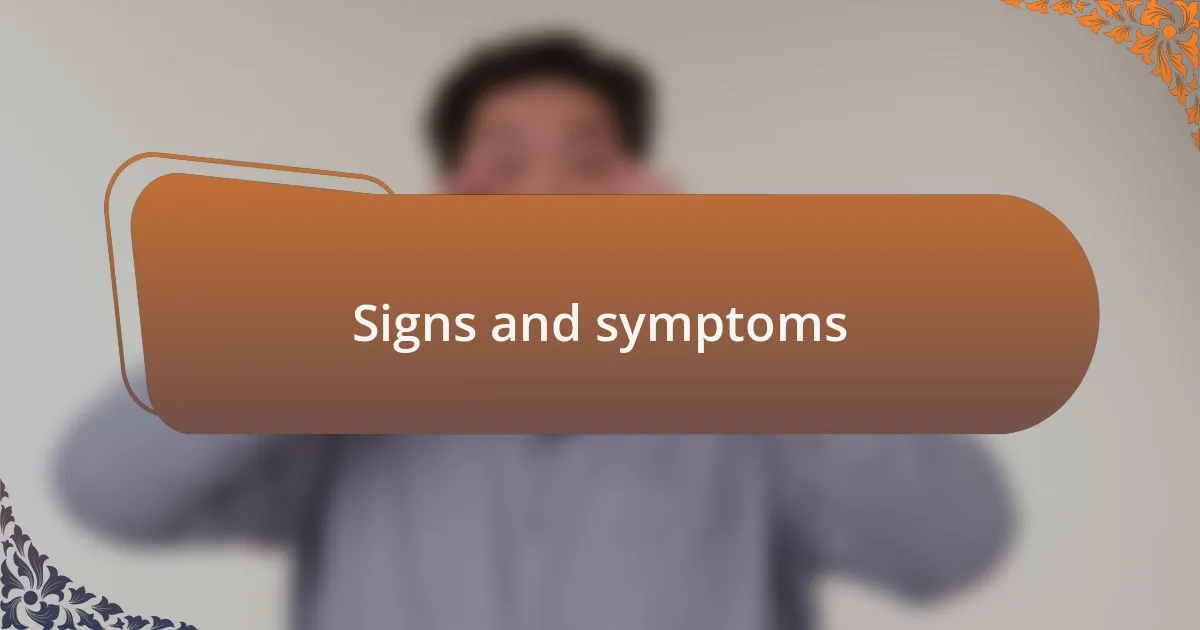
Signs and symptoms
Understanding the signs and symptoms of selective mutism can be crucial in identifying the condition early. Often, I found myself frozen in social situations, feeling an invisible wall between me and the words I wanted to say. This inability to speak can manifest not only in public settings but also around familiar people, creating deep feelings of isolation.
Another symptom I experienced was an over-reliance on non-verbal communication. I resorted to gestures and facial expressions to convey my thoughts, which sometimes led to misunderstandings. Have you ever wanted to express something but felt trapped inside your own silence? It’s that deep-rooted frustration that makes clarity so significant.
In some cases, children with selective mutism may show symptoms like extreme shyness or avoidant behaviors. I remember being anxious even about simple interactions, like greeting a neighbor or ordering food. These behaviors often stem from overwhelming anxiety, making daily activities feel monumental. Recognizing these signs gives insight into the internal struggles faced by individuals, offering an opportunity for deeper understanding and compassionate support.

Strategies for support
Finding effective strategies for support can profoundly impact the journey of someone with selective mutism. I recall a time when my family decided to create a safe environment during family gatherings. Instead of pushing me to speak, they encouraged activities that fostered connection without the pressure of conversation—like drawing or playing board games. This approach allowed me to express myself in ways that felt comfortable, making interactions less daunting.
One strategy that proved invaluable was establishing a routine that included gentle exposure to social situations. I remember participating in small group activities where speaking wasn’t mandatory, like joining a book club focused on reading aloud together. This not only eased my anxiety but also helped build my confidence. Have you ever noticed how familiarity can turn fear into comfort? Gradually, these small steps allowed me to engage more deeply without the expectation to perform.
Support from peers also played a crucial role in my journey. I found comfort in friendships with those who understood my struggles. Just knowing that I could take my time to respond without judgment made a world of difference. How often do we underestimate the power of empathy? It’s essential to create spaces where individuals feel seen and heard, as that sense of solidarity can encourage them to step outside their comfort zones at their own pace.
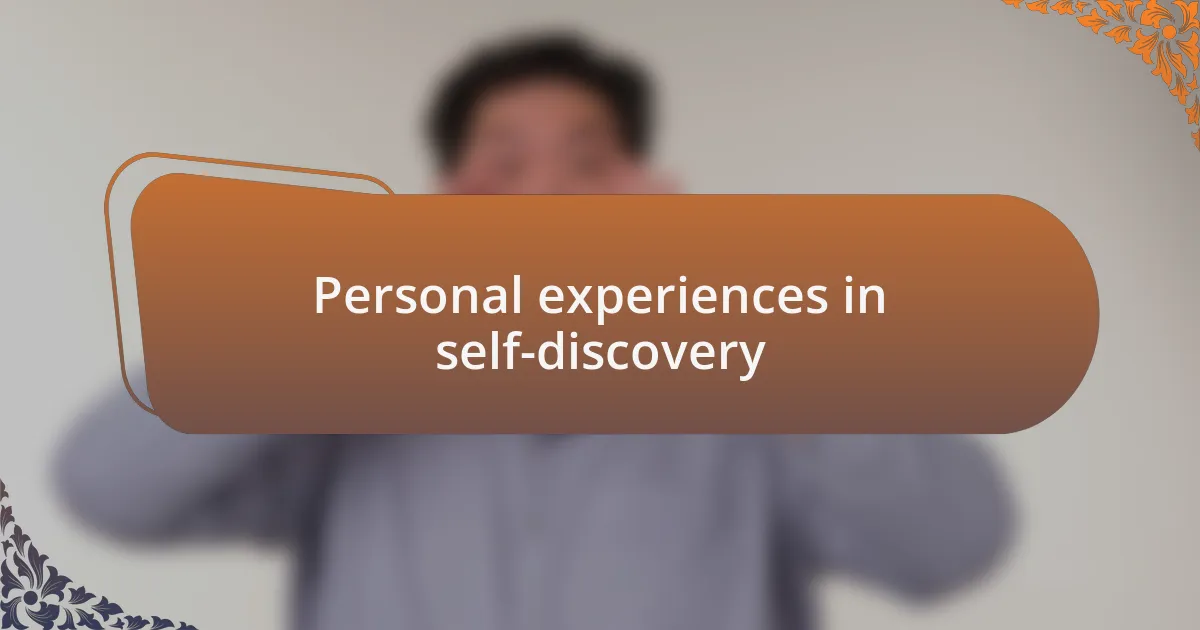
Personal experiences in self-discovery
I remember the first time I journaled about my feelings surrounding my selective mutism. Writing became my refuge, a way to express thoughts that seemed trapped inside. How liberating it felt to pour my heart onto the pages without the fear of judgment! This practice revealed layers of my emotions that I hadn’t fully recognized before, allowing me to understand myself better.
One pivotal moment in my journey happened during a school presentation. Instead of the expected panic, I chose to express my thoughts through visuals, creating a poster that conveyed my message. I felt a rush of pride as my classmates engaged with my work, realizing that communication doesn’t always require words. Have you ever found a different way to share your message? It demonstrated to me that self-discovery isn’t just about overcoming challenges; it can also be about finding alternative pathways to connect with others.
Reflecting on my experiences, I see that vulnerability played a significant role in my self-discovery. There were times I hesitated to share my thoughts, fearing rejection. But when I finally opened up to a trusted mentor, I discovered my journey resonated with many. How powerful is it to realize that your struggles are shared by others? Connecting through these authentic conversations not only helped me better understand myself but also reinforced the importance of community in the journey of self-discovery.
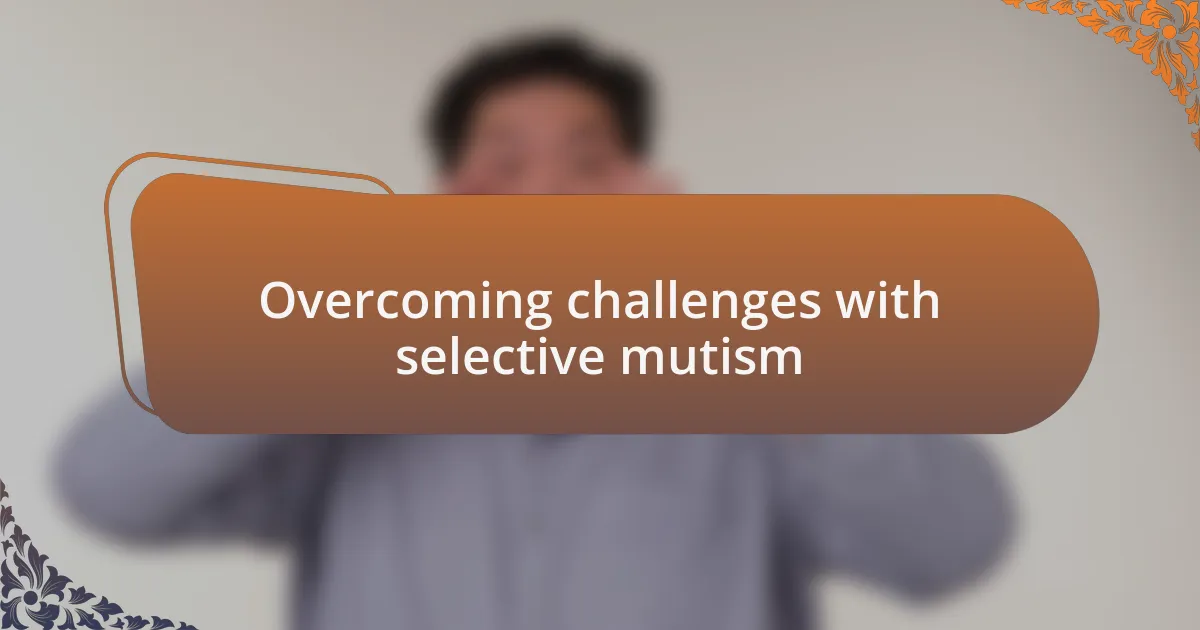
Overcoming challenges with selective mutism
Facing the challenges of selective mutism often means grappling with moments of profound silence. I vividly recall attending a family gathering where I felt completely paralyzed by the noise and chatter around me. Instead of retreating to my safe corner, I decided to communicate through drawing. It surprised me how empowering that choice felt—I was still present, still connecting, just in my own unique way. Have you ever found strength in non-verbal expression?
One of the biggest hurdles was navigating interactions in social situations. There were instances when I wanted to speak up but found my voice lost in nervousness. I began practicing in the mirror, trying to alleviate some of that pressure. With each attempt, I felt a little braver, as if reclaiming pieces of myself that I thought were forever hidden. It was a reminder that overcoming challenges with selective mutism can often be about gradual progress rather than immediate perfection.
Support systems played a crucial role in my journey. I remember the encouragement of a few close friends who created a safe space for me to share my thoughts when I struggled to articulate them verbally. Their patience taught me the beauty of slow conversations filled with understanding rather than rapid exchanges. Isn’t that what connection is really about—being understood, even when words fail us?
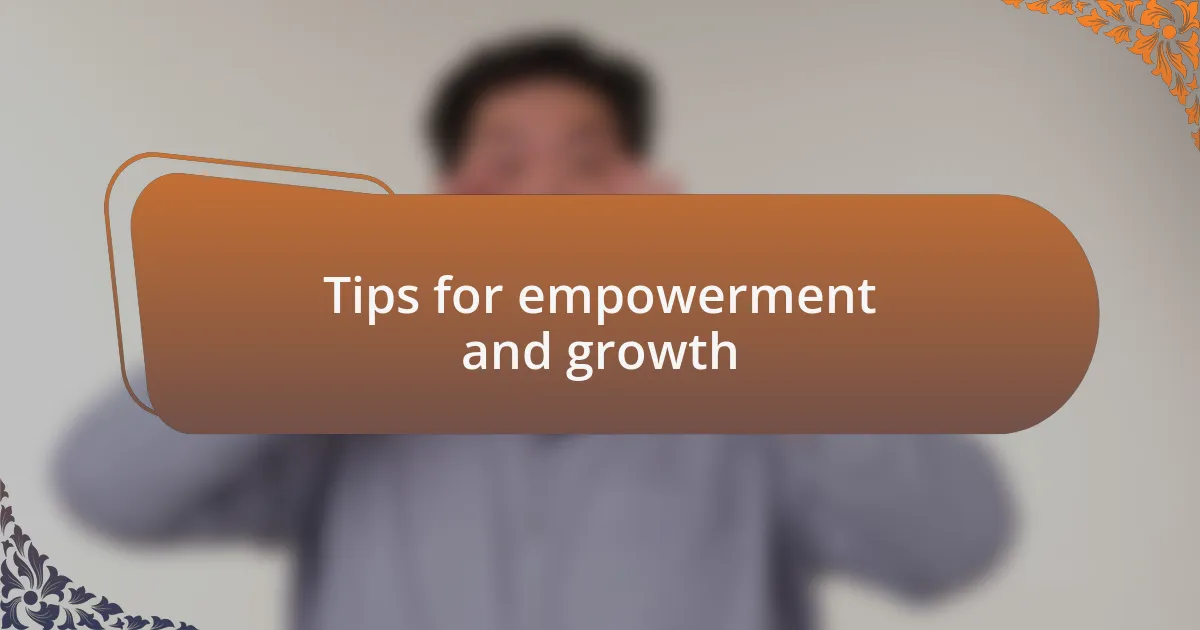
Tips for empowerment and growth
Building self-empowerment often starts with embracing the small victories. I recall when I decided to take part in a local art workshop, even though the thought of interacting with strangers filled me with anxiety. The experience of creating something tangible, amidst a supportive group, ignited a spark within me that I hadn’t felt in years. Have you ever discovered a part of yourself in unexpected places?
Taking risks is a vital part of personal growth. I distinctly remember one week when I challenged myself to speak one sentence each day, whether to a barista or a friend. It felt daunting at first, but with each successful attempt, I gained a bit more confidence. Growth often happens slowly, yet each instance felt monumental, reinforcing that progress isn’t a race, but a personal journey.
Reflection is another powerful tool for empowerment. After a difficult interaction, I would sit down and journal about my feelings—everything from the embarrassment of not speaking to the pride in attempting to engage. This self-reflection helped me understand my triggers and celebrate my efforts, no matter how small. Have you ever found clarity through putting your thoughts on paper? It’s a liberating process that not only fosters growth but also builds resilience.